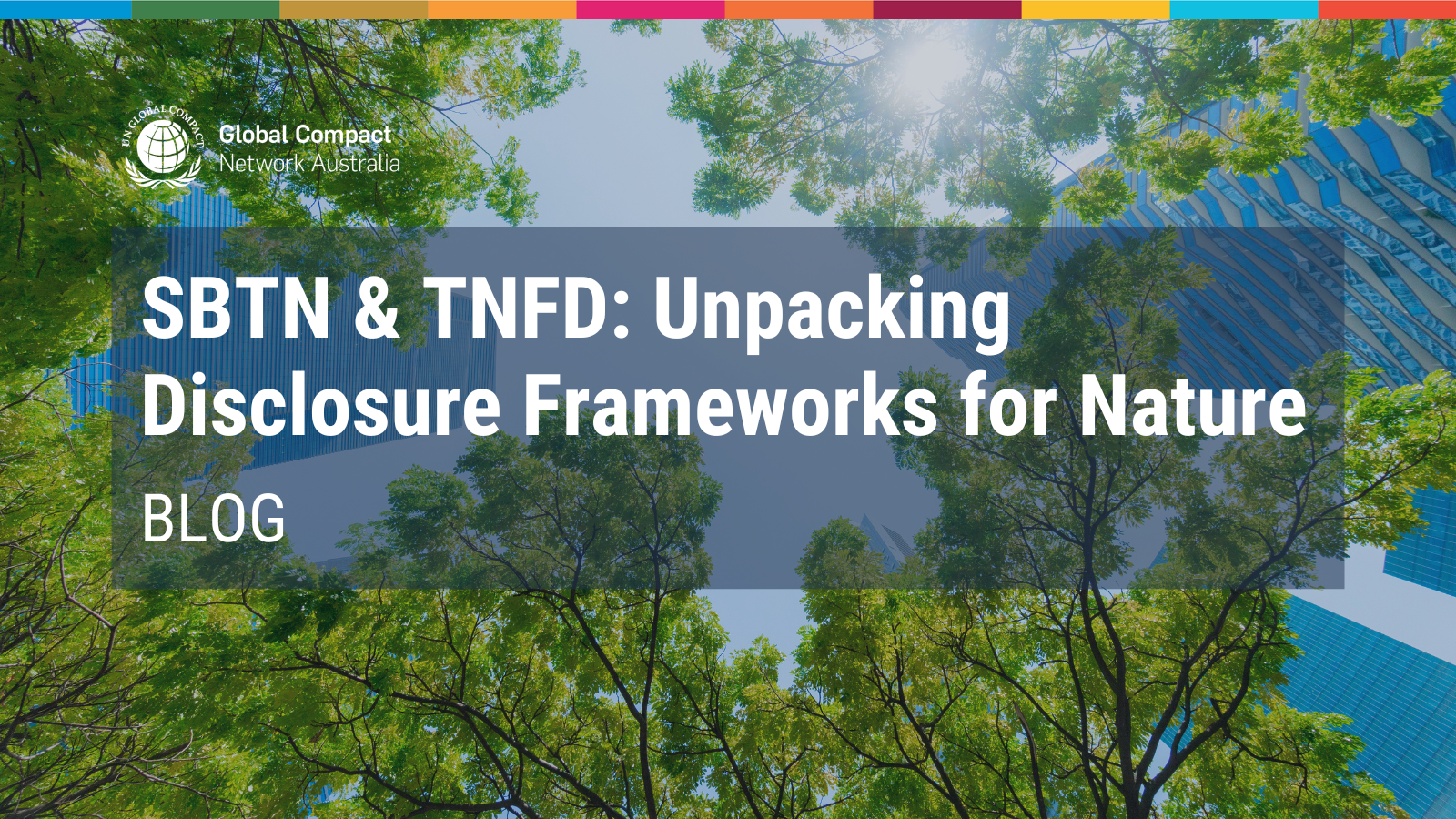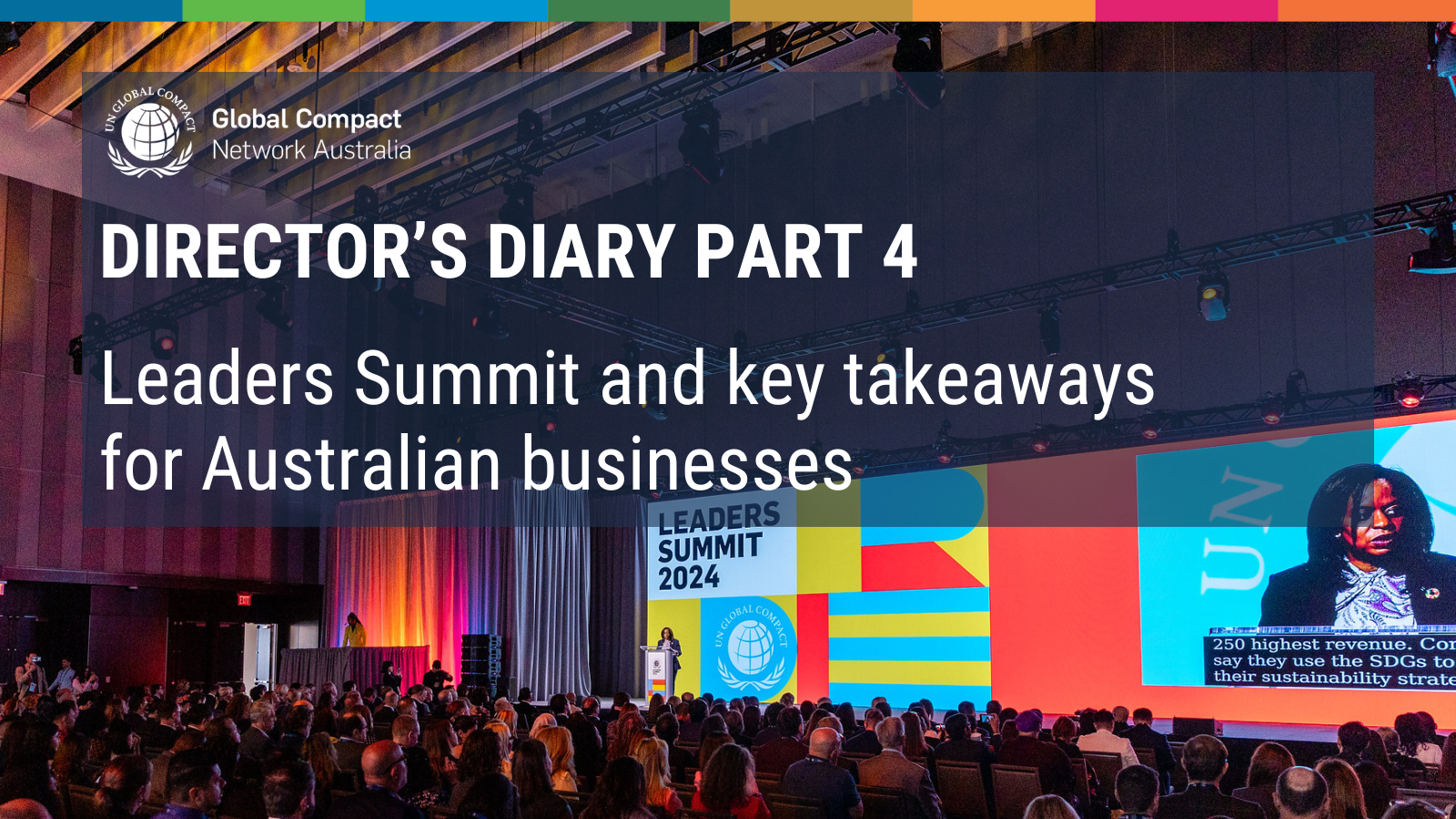
Blogs, Environment & Climate Change, Featured, News, Resources
BLOG | SBTN & TNFD: Unpacking Disclosure Frameworks for Nature
Dr Evan Center | September 11, 2023
Authors: Gregorius Nugroho & Dr Evan Beaumont Center
According to the World Wildlife Fund’s (WWF) latest Living Planet Report, nature is struggling at global scale.[1] Despite our high economic dependence on nature,[2] global wildlife populations have declined by 70% since 1970.[3] Indeed, our ever-increasing economic dependence on biodiversity – paired with the rapid loss and destruction of natural-capital and ecosystems – creates a crisis that exacerbates climate change and demands immediate and worldwide action from businesses, investors and government.
To address this crisis, in December of 2022, the 15th Conference of Parties to the UN Convention on Biological Diversity (COP 15) developed the Kunming-Montreal Global Biodiversity Framework (GBF).[4] The GBF operates as a nature-based equivalent to the landmark 2015 Paris Agreement — highlighted by the 30×30 (or 30 by 30) pledge, which exhorts nations to protect 30% of Earth’s lands, oceans, coastal areas, and inland waters by 2030.
In addition to the 30×30 pledge, the GBF set four goals and 23 targets aimed at protecting global biodiversity. This included goals related to human-induced extinction; sustainable use and management of biodiversity; fair sharing and fair benefits from genetic resources; and adequate access and implementation of the GBF for all parties, especially Least Developed Countries and Small Island Developing States. The subsequent 23 targets established specific objectives for businesses related to biodiversity risk. This included incentives, regulation and resourcing for financing. Notably, the GBF placed particular emphasis on recognising Indigenous Peoples’ rights, roles and knowledge in the protection of biodiversity[5].
Australia’s Response to Biodiversity at the Federal and State & Territory Level
The federal government, alongside the state and territory governments, has begun to engage in the goals and targets set by the GBF. At the federal level, the Australian Government Department of Climate Change, Energy, the Environment and Water (DCCEEW) has recently released the Nature Positive Plan: Better for the environment, better for business.[6] This policy paper answers some of the key challenges from both the 2021 State of The Environment Report and the independent Samuel Review of the Environment Protection and Biodiversity Conservation Act 1999 (EPBC Act). It also outlines Australia’s commitments on achieving its 30×30 pledge goals; setting up the world’s first nature repair market; establishing an independent Environment Protection Agency (EPA); and developing a standalone cultural heritage legislation in partnership with the First Nations people.[7]
At the state and territory level, Australia’s efforts towards preserving biodiversity primarily focus on business-driven conservation projects and ecosystem restoration efforts. These efforts are organised by states and territories.
| States & Territories | Department | Strategies |
| SA | Department for Environment and Water | ‘Think globally, act locally’; National Parks and Wildlife Act 1972; Native Vegetation Act 1991; Landscape South Australia Act 2019; Fisheries Management Act 2007 |
| WA | Department of Biodiversity, Conservation and Attractions | Strategic Directions 2022-25: Nature-based tourism, bushfire risk management, science-based innovative corporate services |
| NT | Department of Environment, Parks and Water Security | Northern Territory Offsets Framework: Biodiversity Offsets Policy |
| ACT | Environment, Planning and Sustainable Development Directorate – Environment | Biodiversity Conservation: Woodlands, rivers and wetlands, grasslands, biodiversity investment plan, ecological connectivity |
| VIC | Department of Energy, Environment and Climate Action | Biodiversity 2037: Valuing nature and healthy natural environment |
| NSW | Department of Planning and Environment | Biodiversity Conservation Program: ‘Saving our Species’ (SoS); Biodiversity Conservation Act 2016 |
| TAS | Department of Natural Resources and Environment | Natural Heritage Strategy for Tasmania (2013-2030): Securing our Natural Advantage |
| QLD | Department of Environment and Science | Conserving Nature: A Biodiversity Conservation Strategy for Queensland; Natural Capital Program |
Science Based Targets Network (SBTN)
The Science Based Targets Network (SBTN) helps companies, investors and cities set science-based targets for nature, which cover biodiversity, freshwater, land, ocean and climate (using the Science Based Targets initiative (SBTi)).[8] This initiative is best illustrated through its ‘nature-positive‘ focus.[9] The SBTN’s framework helps companies and cities develop better regulatory risk management, better reputation, increased investor confidence, opportunities for innovations and collaborations, and improved medium-to-long-term profitability. For Australian businesses, efforts to support them with SBTN initiatives are conducted by the UN Global Compact Network Australia via the formation of a working group that supports better nature-positive business engagement by the end of 2024.
Although the SBTN and SBTi are different organisations, SBTN builds upon the momentum created previously by the SBTi.[10] Accordingly, the SBTN endeavours to extend the scope of SBTi — which focuses on setting decarbonisation targets for climate action – to also include setting targets for nature and biodiversity.[11]
The SBTN is also one of the initiatives promoted by the Global Common Alliance (GCA).[12] The GCA is an organisation comprised of businesses, advocates, campaigners, scientists, and philanthropists whose efforts focus on safeguarding the earth’s global commons including works in humanity. They strive to align with the evolving science on nature and climate through the Earth Commission initiative convened by Future Earth. Notably, membership includes several key authors in the latest Intergovernmental Panel on Climate Change (IPCC).[13] Likewise,
Taskforce on Nature-related Financial Disclosure (TNFD)
The Taskforce on Nature-related Financial Disclosures (TNFD) provides a framework for companies to manage and disclose risks associated with nature.[15] These nature-related risks are further categorised into physical, transition, and systemic risk.[16]
Physical risk comes in the form of direct disturbance to a functioning business due to heavy reliance on nature, such as the declining harvest yield because of loss of pollinator species. Transition risk arises from the misalignment of a business’s operations and strategies with the current regulatory or policy landscape, like potential litigation or fines coming from a new law on deforestation. Systemic risk is much broader and can be thought of as risk coming from the destruction of an entire networked and interlinked structure. As an example, the destruction of the Great Barrier Reef results disturbance of the entire ocean ecosystem resulting in the loss of fish stocks from their destroyed breeding grounds.
The main objective of the TNFD framework is to drive a global financial shift via a better allocation of assets, moving a nature-negative impact towards a nature-positive focus.[17] As global business operations rely heavily on nature – with nearly the world’s GDP dependant on natural-capital and ecosystem services – nature-related financial risks are highly material, which increases the importance of the framework for disclosure and management of those risks.[18] Accordingly, the TNFD aims to provide good information for businesses and investors to manage and shift their strategies, operations, and financial allocations. Notably, in Australia, the Responsible Investment Association of Australasia (RIAA) is the Convenor of the TNFD Consultation Group for Australia and New Zealand, with the final version of the TNFD scheduled for release in September 2023.
SBTN & TNFD
The SBTN intersects with several other frameworks – such as the NCP, CDP, BDP, GRI – and is designed with TNFD interoperability in mind.
Pollination Executive Director, Guy Williams – a technical contributor to the development of both TNFD and SBTN frameworks – explains that “both the SBTN and TNFD have worked in close collaboration as knowledge partners to drive this strong alignment and consistency.”
“The SBTN and TNFD have been co-designed to ensure that this need not be an either/or decision for businesses as they seek the tools and support to help chart their course towards nature positive,” he adds.
“If nature positive is our north star, then we can see the TNFD as our telescope to see this star more clearly, and SBTN as our star chart to help us start travelling in that direction,” says Williams. “With TNFD helping to craft consistent discourse and disclosure of a business’s exposure to nature related risks and opportunities, and SBTN as the toolbox to setting robust science-based targets for nature, both frameworks provide critical and complimentary pieces of the nature puzzle.”
Ultimately, both frameworks seek to produce sound information that helps mitigate environmental impact. In this manner, each framework seeks to collect, interpret and disclose impact-related data – and this alignment is further detailed on the SBTN FAQs page.[19]
The table below provides a high-level example of how a company can apply both frameworks and to highlight the alignment between the frameworks.
| Company Context | SBTN Framework | TNFD Framework |
| Company A is a fisheries farm with both nurseries and grow-out facilities exclusively located in Australia.
|
The 5-Steps Framework
– Step 1: Assess It is identified that their most material pressures on nature are land/water/sea use change, resource exploitation, pollution, and invasive species. |
The LEAP Framework
– Locate Their grow-out farms interface with the ocean and their nurseries use freshwater and are land-based.
|
| – Step 2: Interpret & Prioritise
After doing some hotspot mapping of impacts and dependencies on nature, they decide to prioritise to address issues on their nursery facilities all over Australia. |
– Evaluate
Their dependency on nature lies on the importance of water temperature and their impacts on nature is coming from their cultured fish population which increases BOD and incidents of disease outbreak. |
|
| – Step 3: Measure, Set, Disclose
They then measure some baseline data regarding those operations such as the area of land converted into nurseries and the volume of freshwater used, set targets on those, and disclose. |
– Assess
They found out that the most material risk facing their business is the disease outbreak.
|
|
| – Step 4: Act
After setting the targets, a plan of action needs to be made to deliver those targets such as experimenting new technologies to increase water-use efficiency. |
– Prepare
They will have to disclose on how they can mitigate this risk for example through investing on certification programs and disease prevention measures. |
|
| – Step 5: Track
Making sure to track progress through interim targets and disclosure. |
Conclusion
Our global, national and local economic systems are dependent on an environment that can sustain us while mitigating the already devastating effects of anthropogenic climate change. As nature risks increasingly impact businesses, investors and municipalities there is a need for multi-pronged solutions.
Determining how to engage with nature issues should not be an either/or choice among frameworks – it is important to see how they all fit together and play part of the role in helping to address the issue. Ultimately, to rapidly progress the goals of the GBF, we’ll need businesses, investors and governments to use frameworks like these to assess, disclose and mitigate their impact at scale.
UN Global Compact Network Australia
We’re working hard to progress policies and support positive business practice in both the nature and climate space. We’d love to hear what your organisation is doing to better disclose its impact on nature and biodiversity. Get in touch with us at the UN Global Compact Network if you’d like to share challenges, successes and opportunities for the private sector to better support the targets set by the GBF.
Are you assessing your organisations nature impact? We want to best support our UNGCNA participants. Please fill out this very short survey and help us better support your nature-positive needs: UNGC Natural Capital Survey.
Additionally, if you’re not yet a participant and your organisation is doing good things in this space, we’d love to see how we can better work together. Please contact us here for more information on how to join our Australian Local Network of the UNGC.
References
[1] World Wildlife Fund (WWF), Living Planet Report 2022 : Building a Nature-positive Society, 2022. Available at: https://assets.wwf.org.au/image/upload/f_pdf/file_living_planet_report_2022_final?_a=ATO2Bfg0
[2] World Economic Forum, Nature Risk Rising : Why the Crisis Engulfing Nature Matters for Business and the Economy, Jan 2020. Available at: https://www3.weforum.org/docs/WEF_New_Nature_Economy_Report_2020.pdf
[3] World Wildlife Fund (WWF), ‘Living Planet Report’, WWF, 2022, https://wwf.org.au/what-we-do/living-planet-report/, (accessed on 24 Jul 2023).
[4] United Nations Environment Programme (UNEP), ‘UN Biodiversity Conference (COP 15)’, UNEP, 2022, https://www.unep.org/un-biodiversity-conference-cop-15, (accessed on 24 Jul 2023).
[5] United Nations Environment Programme (20 December 2022) COP15 ends with landmark biodiversity agreement. Available at: https://www.unep.org/news-and-stories/story/cop15-ends-landmark-biodiversity-agreement (Last accessed 28 February 2023)
[6] Australian Government Department of Climate Change, Energy, the Environment and Water (DCCEEW), Nature Positive Plan: Better for The Environment, Better for Business, Dec 2022. Available at: https://www.dcceew.gov.au/sites/default/files/documents/nature-positive-plan.pdf
[7] DCCEEW, p. 1.
[8] SBTN, ’Why Science Based Targets Network?’, SBTN, 2021, https://sciencebasedtargetsnetwork.org/our-mission/why-sbtn/, Accessed on 24 Jul 2023.
[9]We recognise that there the term ‘nature-positive’ has brought debate, due to an essentialising connection between baseline economics and nature. The SBTN addresses this specifically here: https://sciencebasedtargetsnetwork.org/news/business/nature-positive-an-opportunity-to-get-it-right/, Accessed on 31 Jul 2023. Of note, in line with the Ten Principles and SDGs 14 & 15, the UNGCNA supports context-based definitions of materiality, especially in regards to natural capital. See UNRSID for more: Making Materiality Determinations: A Context-Based Approach | Publications | UNRISD
[10] Science Based Targets Network (SBTN), Science-based Targets for Nature Initial Guidance for Business, Sep 2020, Available at: https://sciencebasedtargetsnetwork.org/wp-content/uploads/2020/11/Science-Based-Targets-for-Nature-Initial-Guidance-for-Business.pdf.
[11] ‘Nature’ is defined as all the interactions happening between the living and the non-living components (including climate) of the ecosystems (freshwater, land, ocean) and ‘biodiversity’ puts an emphasis on the different varieties of those living components and ecosystems. SBTN, p. 3.
[12] Science Based Targets Network (SBTN), ’Global Commons Alliance’, SBTN, 2021, https://sciencebasedtargetsnetwork.org/our-mission/global-commons-alliance/, Accessed on 24 Jul 2023.
[13] Global Commons Alliance (GCA), ’Earth Commission: Science’, GCA, https://globalcommonsalliance.org/alliance-projects/earth-commission/, Accessed on 31 Jul 2023.
[14] Global Commons Alliance (GCA), ’About the Global Commons Alliance’, GCA, https://globalcommonsalliance.org/about/, Accessed on 24 Jul 2023.
[15] Taskforce on Nature-related Financial Disclosures (TNFD), ’About’, TNFD, 2022, https://tnfd.global/about/, Accessed on 24 Jul 2023.
[16] TNFD, ’Concepts and definitions’, TNFD, 2022, https://framework.tnfd.global/concepts-and-definitions/definitions-of-risks/, Accessed on 24 Jul 2023.
[17] TNFD, ’Our mission’, TNFD, 2022, https://tnfd.global/about/#mission, Accessed on 24 Jul 2023.
[18] World Economic Forum, Nature Risk Rising : Why the Crisis Engulfing Nature Matters for Business and the Economy, Jan 2020. Available at: https://www3.weforum.org/docs/WEF_New_Nature_Economy_Report_2020.pdf
[19]Science Based Targets Network, ’FAQs‘, SBTN, 2022, https://sciencebasedtargetsnetwork.org/resources/frequently-asked-questions/, Accessed on 14 August 2023.


